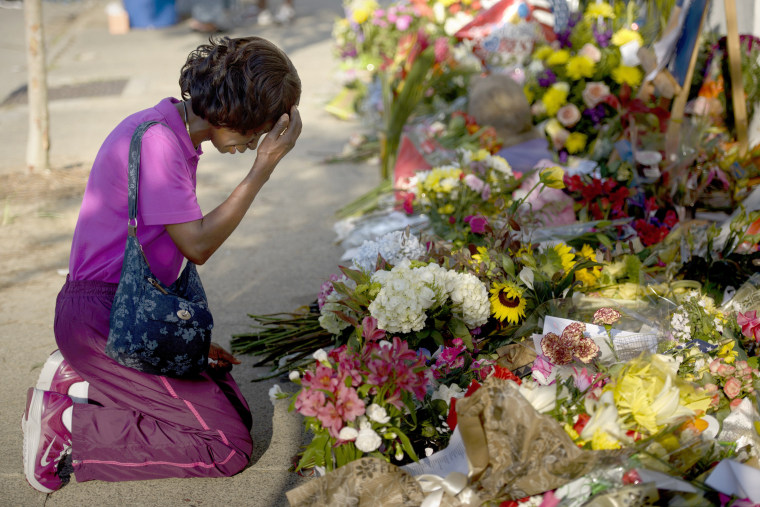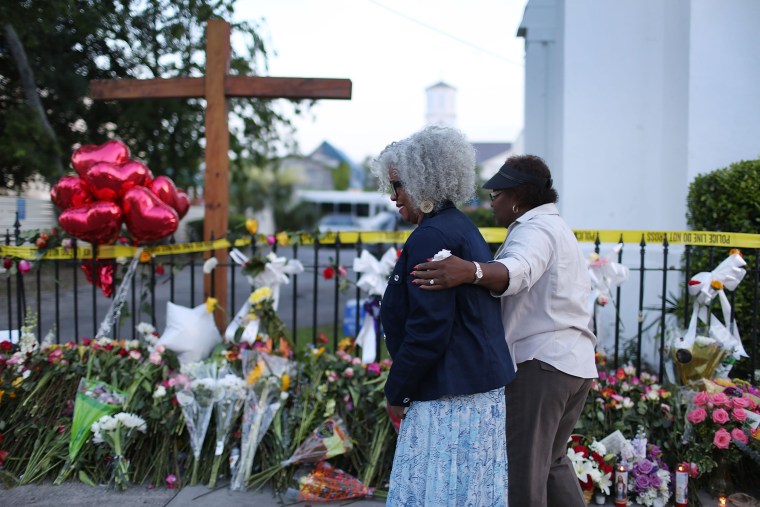A white racist stands accused of killing nine black men and women during a Bible study at one of the oldest black churches in America, yet some white Americans are hesitant to tie the attack to racism -- preferring instead to relegate the shooting to an isolated tragedy separate from our country’s legacy of racism that can be solved by putting Dylann Roof to death and labeling him mentally ill.
The narrative plays up the progress African-Americans have made in this country without acknowledging how far we as a nation still have to go. But how can we move forward when so many just want to move on?
RELATED: Hate Crime in America, by the Numbers
“It goes to the history of this country not really ever wanting to tackle these issues and wanting to brush them aside and say, ‘You should get over it,’” said Daniella Gibbs Leger, who studies the intersection of race, politics, and media at the Center for American Progress.
Roof reportedly told a witness that his motive for the killings was that blacks “rape our women and are taking our country.” Despite this declaration, Gov. Nikki Haley mused on her Facebook page: “While we do not yet know all of the details, we do know that we'll never understand what motivates anyone to enter one of our places of worship and take the life of another.” On Friday, Haley called for Roof to be sentenced to death for the shootings.

And in a Thursday night interview, Republican Sen. Lindsey Graham, who is seeking his party’s nomination for president in 2016, referenced his experiences encountering hate in the Middle East -- as if he was not born and raised in South Carolina under Jim Crow, which legally, violently, and systematically oppressed millions of black people for decades.
Graham was not the only GOP candidate who ducked labeling Roof as a racist killer. Former Texas Gov. Rick Perry on Friday suggested drugs were to blame and called the shootings “an accident.”
And while the official state flag flew at half mast Thursday, many African-Americans were offended that the Confederate flag—seen as a symbol of the South’s painful racial past—remained in front of the state Capitol full mast, or that it still flies at all. Graham defended the flag Friday as “part of who we are.”
In a Washington Post op-ed, University of Pennsylvania religious and Africana studies professor Anthea Butler wrote:
“Listen to major media outlets and you won’t hear the word “terrorism” used in coverage of Tuesday’s shooting. You won’t hear the white male shooter, identified as 21-year-old Dylann Roof, described as “a possible terrorist.” And if coverage of recent shootings by white suspects is any indication, he never will be. Instead, the go-to explanation for his actions will be mental illness. He will be humanized and called sick, a victim of mistreatment or inadequate mental health resources. That is the power of whiteness in America.”
Media reports in the wake of the shooting have characterized Roof, a 21-year-old man, as “a kid.” Such a characterization, or allusions to mental illness are offensive because they attempt to distance Roof from his actions—and from history, Leger explained.
"When you make a lot of progress, there are people who feel threatened by it and particularly emotionally disturbed people will respond to it in a way that is often dysfunctional, damaging and horrific.”
"It’s all of this removing the responsibility from a racist adult,” she said. “If he’s a child, his capacity (to commit such a crime) wasn’t fully formed. Maybe he was swayed by somebody else.”
This is not an isolated incident in the history of our country, or even in the history of Emanuel AME Church, the site of the shootings. The church was burned to the ground after co-founder Denmark Vesey was caught and killed for organizing a slave revolt in 1822. Church members met in secret for decades before the end of the Civil War.
President Barack Obama on Thursday also drew comparisons between the Charleston shootings and the long history of violence against African-American churches as a means of enforcing white supremacy.
The Justice Department moved swiftly, signaling that they will investigate the shootings as a hate crime. But stark reminders remain of two separate Americas.

The most recent Gallup polling shows the widely disparate attitudes between black and white Americans. Among their findings:
- A June 2015 poll found blacks are three times more likely than whites to identify race relations as the country’s top problem.
- As of last June, only a quarter of whites believed the criminal justice system was biased against black people -- but nearly 60 percent said they had either a “great deal” or “quite a lot” of confidence in police.
- In the same poll, the majority of whites (67 percent) were “very satisfied” or “somewhat satisfied” with how blacks are treated in the U.S., compared to less than half of blacks (47 percent).
- A majority of whites believe the country’s racial differences will eventually be worked out; blacks were evenly split on the question.
- Overwhelming majorities of whites believe blacks have a fair shot at education, housing and employment. Only slim majorities of blacks believe the same about education and housing, and a majority of blacks disagreed on the question regarding employment.
“This person is indicative of a growing number of people that are joining these fringe white supremacist groups and openly talking about their hatred,” said Leger.
RELATED: Essay: We Can't 'Feel No Ways Tired'
NPR media critic Eric Deggans, said Roof is the latest angry white American who has lashed out over a changing country.
“Racism is alive, but … he was looking around and seeing a world where he felt races were becoming more equal and that scared him and angered him,” said Deggans, who comments frequently on race and the media. “When you make a lot of progress, there are people who feel threatened by it and particularly emotionally disturbed people will respond to it in a way that is often dysfunctional, damaging and horrific.”
Which makes Roof not an anomaly, but part of our country’s ugly past.
“There’s a desire to say ‘This is just a lone wolf,’” Leger said. “There seem to be a lot of lone wolves these days. What exactly is happening?”